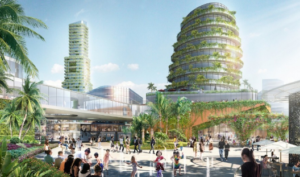
Sasaki Associates recently unveiled some preliminary details regarding an ambitious mixed-use development in Malaysia, that's expected to run to a budget of tens of billions of dollars. Dubbed Forest City, the multi-phase project is billed as a potential new cultural and economic hub for the region.
Spanning over 1,386 hectares (3,424 acres) and expected to take over 20 years to complete, the Forest City project is slated for four man-made islands in Iskandar that are well-placed to serve as a link between Singapore and Malaysia. Its budget is rated variously at US$41 billion and $58 billion in the press materials.
Sasaki Associates designed the masterplan as an ecosystem that mimics the natural coastal ecologies of the region. The project will boast the world's largest green roof system in addition to a slew of other features.
Master Plan Details
Strategically located adjacent to the economic powerhouse of Singapore, Forest City is a new global cluster of commerce and culture. Designed to cultivate a live/work lifestyle, it is comprised of financial institutions, technology and biotech research facilities, and a variety of creative industries that will establish an innovative and sustainable employment base providing an estimated 220,000 new jobs in southern Malaysia. The development's approach to city-building makes Forest City an ideal destination for an emerging generation of Malaysians that seek to live in a compact and walkable mixed-use metropolis with a variety of civic, cultural, and recreational amenities set within a lush tropical landscape. With multiple modes of public transportation—including an extensive ferry network and light rail transit system that links to Singapore's MRT and Malaysia's high-speed rail line to Kuala Lumpur—Forest City will be connected to the world.
Sasaki's master plan for Forest City seeks to establish a symbiotic relationship between development and the natural environment. Organized around the Seagrass Preserve – a critical ecological feature of the region – Forest City embraces this unique marine sanctuary with a contiguous network of complementary waterfront landscapes that offer opportunities to learn about and protect the region's ecosystems. With 31.4 linear kilometers of coastline, edges are designed to mimic naturally occurring features of Malaysia's coastal ecosystems, including tidal pools and shallow bays that provide critical marine habitat and support local fisheries. The most essential of these is Forest City's restored mangroves, which provide over ten linear kilometers of essential habitat and help to improve regional water quality.
In addition to the extensive ground-level parks and waterfront trail system, Forest City offers a new paradigm for the public realm—linking the entire development is a pedestrian-centric rooftop network of interconnected parks and gardens located on the top level of the infrastructure podium. This approach establishes a publically accessible landscape as a continuous urban structure and is a defining element of Forest City, creating the world's largest green roof system. Beyond a simple rooftop landscape, the podium parks provide native habitat zones, filter and cleanse stormwater, and provide recreational opportunities in an entirely automobile-free public realm.
Forest City's success, as with any global center, relies on its ability to efficiently establish a highly efficient transportation system with clusters of development adjacent to public transit, promoting a compact and walkable urban environment. This innovative transportation network is interconnected with a multi-layered approach, integrating vehicular roadways, car parks, a light rail transit system, and pedestrian public realm. Designed to prioritize pedestrian connections, infrastructure related to vehicular traffic is located at the ground level, while a contiguous system of public space forms a new public realm adjacent to transit stations on the top level of the infrastructure podium. Throughout each island, density and civic uses are organized around these transit centers, ensuring the majority of Forest City's future population will live within a 5- to 10-minute walk of public transportation.
Sources
Sasaki. Forest City Master Plan. 2016
New Atlas. Ambitious Forest City development planned for Malaysia. 2016
Inhabitat. Malaysia’s Forest City will feature the world’s largest green roof system. 2016